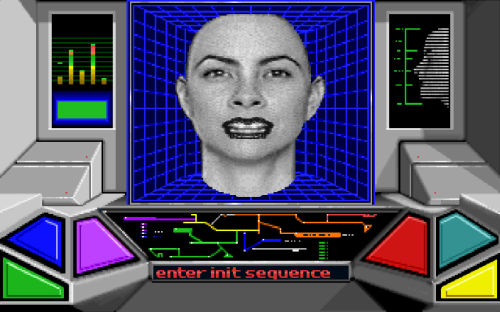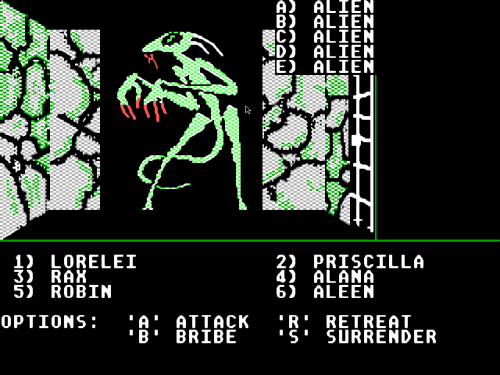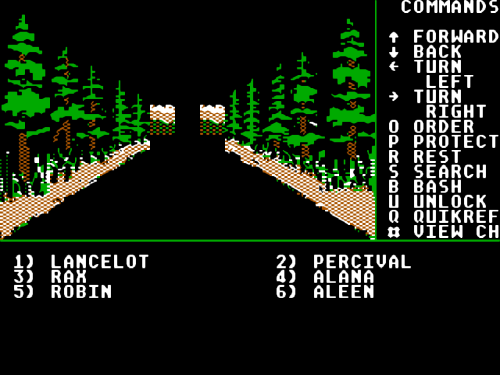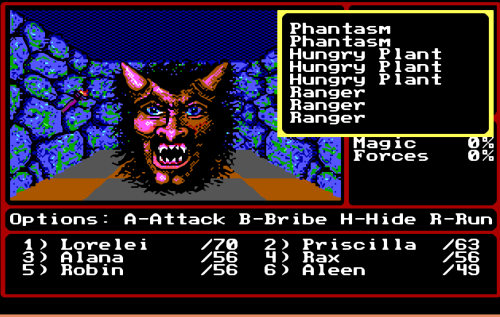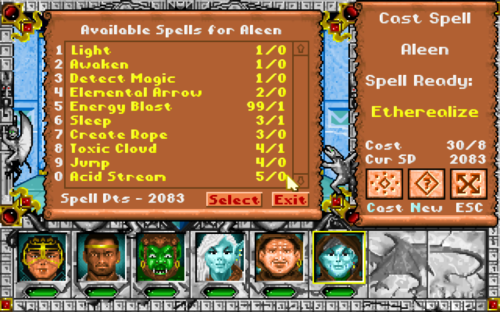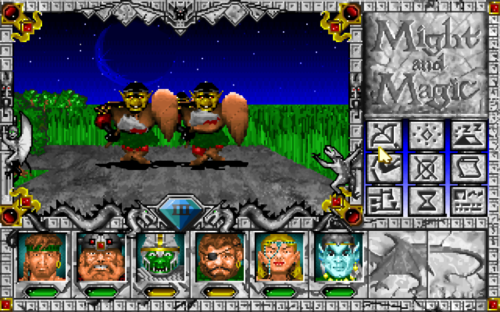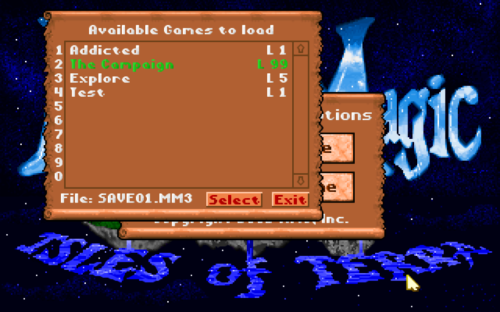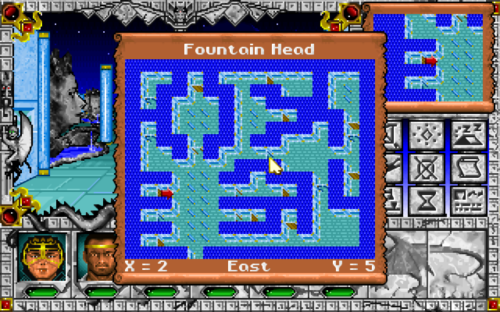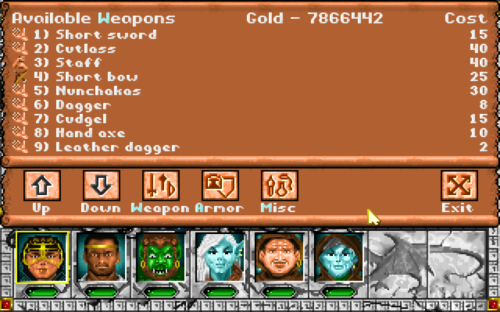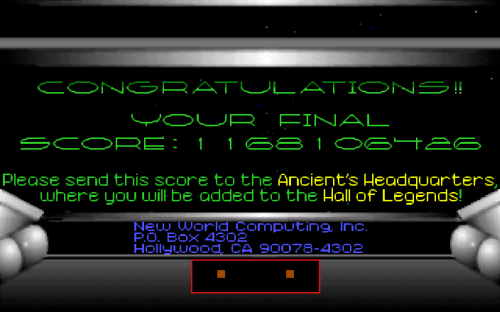There was a marathon during the past week and a half, so Might and Magic III: Isles of Terra is now officially on the completed list. I intend to make a set of quick and easy guides providing information I couldn’t find online when I was playing the game, but for now, I thought I’d make a sort of “looking back” report. It’s a big and lengthy game, so my impressions have changed, several times during my playing of it.
A comparison of the first three games
Might and Magic Book One: Secret of the Inner Sanctum
Might and Magic Book One was released in 1986, the year I was born. It’s probably a few months older than me, since my birthday is in December.
In this game, you create a party of six characters, choosing between a
- Knight – pure fighter
- Robber – thief type, able to unlock doors and disarm traps, which they mostly fail
- Sorcerer, Cleric – pure spell casters, each with their own group of spells, with some overlap between
- Archer and Paladin – Sorcerer/Knight and Cleric/Knight hybrids, respectively
Magic is accessible as a character grows in level, automatically. Hybrid classes do not have access to higher spell levels and gain access to lower spell levels at a slower pace.
Combat is turn based and pushing a letter based. You pick what you want to do when that character is up and then pick who to do it on, be it a spell, an attack or a defensive option. There are two ranks for each side, front and back. Depending on the move, you have a different choice of targets. I should note that the special thing about the archer is that they can also use their ranged weapon to shoot back ranks of enemies in combat, and they’re really good at it.
Enemies aren’t part of the world. Encounters are at fixed locations or happen at random and you get taken to a separate combat screen.
There are also races and they affect some starting attributes, but that’s about it. The races are Gnome, Dwarf, Elf, Human and Half-Orc.
You get to pick alignment and sex of your characters to. This changes how certain events in the game affect them, or how to deal with certain monsters. Both of these aspects of a character can also be changed in certain places in the game.
There’s also character age. Older characters have a chance to die. Time passes in the game as you do things and move around and some monsters can also age them with their attack. Luckily, there’s a place in the game as well as a clerical spell that reduces a character’s age to as low as you need it to be.
The graphics are basic and it’s hard to rely on your eyes to memorize and navigate the world, because everything looks to similar. Because of that, the main challenge of the game is drawing a map with proper notations and keeping a list of other notes.
Managing equipment is also made difficult by the interface. There are no in-game stats other than the price, so you have to resort to the manual to figure out what does what.
There are three resources – gold, food and gems. Both gems and gold are a bit lacking at the start of the game, but you’re swimming in them by the end. Gems are used as extra reagents (in addition to spell points), for most of the good spells. Each character carries their own stash, but you can divide it between them as you please. Food is used for resting – you can’t rest without it.
You don’t save the game. It’s saved automatically when you return to an inn in one of the five towns. The game world, for the most part, doesn’t save at all; only your party does. This means that all encounters reset and everything is back in the initial state when you go back to an inn. There’s only one thing in the game, to my knowledge, that does save.
This means that if you die, your progression is technically gone. In practice, the point of the game is to draw a map, so you can’t really lose that progression – it’s right there on your desk, next to you. Training the party is easy, in comparison.
This also means that playing with maps that were already drawn is a completely different experience and I wouldn’t recommend it to any big CRPG fan.
There is very little to explicitly guide you through the game. There are a few quests, with the party able to do one quest at a time and a spell to remove the current quest if you want to try something else.
Several lords in several castles are the main quest givers and their quests usually involve going into some dungeon or cave and killing some enemy, or simply bringing back some items. This is also one type of persistence – which quest you’re on and which you’ve solved is saved on the party, so the king knows which quest to give you next. However, if you solve all the quests for one lord, they simply start back from the first quest. Since the dungeons aren’t saved, you can do them all over again.
There are also one or two larger quest chains that take you through the main story of the game, or at least part of the way. By larger, I mean they consist of five or six tasks you need to accomplish one after the other.
The thing that these quests and the rest of the world have in common is that they don’t outright tell you what to do and where to go.
Instead, the flow of the game can be summarized with explore everything.
You go to a level-appropriate location, each of which is a 16 by 16 grid of tiles, explore it entirely and note everything you’ve found. You’ll find items, events and messages, as well as plenty of combat. As you gather messages and go through events, the world slowly unravels before you, and eventually, thanks to your linking all your notes together, you’re able to solve the Secret of the Inner Sanctum and complete the game.
You aren’t led on a leash. You’re given a world and everything you need to figure it out on your own. This is an amazing approach. It isn’t made perfectly and there are a lot of flaws to the game as old as this, of course, but it’s refreshing these days.
Just for the sake of having a complete summary, the world is made up of 20 sectors, labeled A-F across and 1-4 from top to bottom. Each sector, just as any other location, is a map of 16 by 16 tiles. There are five towns, three lord castles, one king’s castles and various other locations, all of them, again, the same size – 16 by 16.
The biggest flaw? It’s a game from 1986, so the interface is clunky. Even drawing a map is difficult due to the simple graphics. Having to keep a list of spells next to you on the desk, or in a document on your computer gets tedious quickly. A lot of the difficulty comes from good design and is exciting and feels great, but a lot also comes from technological limitations and a game like this would benefit from removing those.
I would absolutely love a modern remake of the first few games, keeping the content the same, but improving the interface.
Might and Magic Book Two: Gates to Another World
Might and Magic Book Two was from the year 1988. The graphics have noticeably improved, but it’s still very much the same game.
Again, you only save when you return to the inn, so the progression is similar. The overall design is similar to.
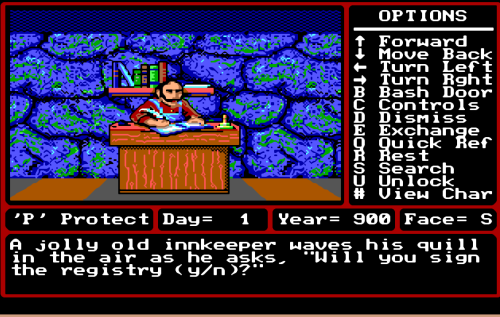
Pictured: The inn menu in Might and Magic Book Two. The game remembers your last party selection now.
Two classes have been added. The Barbarian is a knight with more health and offense, but less equipment choices and less protection. The Ninja is a robber with less thieving skill, but more offense and equipment choices.
Magic is now learned from guilds in various towns, or for certain spells, from special places in the world. Learning it in guilds as an attached price, as well as a price of guild membership.
Skills have been added. Each character can learn up to two skills, one of which is thievery, which robbers and ninjas start with. Thievery is special because it increases with levels, but the other skills provide their benefit by simply being there. You learn them from trainers in various places.
The interface has been greatly improved, but it isn’t quite there yet.
You still don’t have a proper list of spells, but you at least get to see which are available to you, shown as a list of numbers with check boxes next to them.
Equipment management is less tedious, but still tedious. Strength for some items is indicated by enchantment level (+1, 2, 3, etc. next to the name), so you can at least figure out a Short Sword +3 is weaker than a Short Sword +5. For everything else, you can pay the blacksmith to have an item identified for you, but this information isn’t saved anywhere, so you either have to write it down or pay again next time.
There’s a rudimentary auto-map now, which you access by pressing a button. If you have the proper skill, it maps out the layout of a location, but doesn’t remember any special features, only geography. There’s also a mini-map in the corner, which you get by casting one of two spells – Eagle Eye for outdoors and Wizard Eye for dungeons. Both are quite costly. Both maps show your orientation as well.
The basic structure is the same. There are five towns and several castles. Lords now offer a range of quests with different levels of difficulty, but they are simply random tasks now, except for the highest difficulty level.
You play the game in the same way – go to a location, take note of and map out everything and move on to the next one. Eventually, you slowly unwrap the game.
There’s a special set of class-specific quests now to, for every class except for the robber. Only characters of that specific class as well as a robber can go on a class-specific quest. Luckily, there are multiple hirelings for each class, so most of it isn’t too difficult. Solving these quests is a requirement to progress the game past a certain point.
The game now has a fixed time limit of 100 years, but this is difficult to reach and there’s no real danger of running out of time. There’s time travel to, but this doesn’t affect the time limit. You can go back in time to specific years to accomplish a few specific tasks and the game always takes you back to your current year after a while.
Age matters about as much as it did in the first game. You can die of old age, but there’s a spell that completely removes that danger.
There’s also an annoying degree of level scaling in the game. With higher party levels, each fight will have a host of low level creatures added to it, not increasing the difficulty, but certainly increasing the length of battle and the tediousness of it.
Overall, it’s Book One 1.5. A new world, with a few new things that plays just like the first game did.
Might and Magic III: Isles of Terra
Might and Magic III had three years to build upon the first two games and it used them up completely.
There’s a new spell school – nature magic. With it, there are two new classes – Druid and Ranger. One is pure spell caster and the other is a fighter/spellcaster hybrid. All classes have access to all spell levels now. You can learn most if not all the spells in guilds, but you can also find scrolls to learn them from for free if you explore.
Spells are now picked from a list and there’s a lore description of each spell at a guild. You need to resort to the manual to see what they actually do, but that’s possible to memorize and from that point, the game interface is all you need.
Enemies are now part of the world and you can see them before engaging. Ranged attacks can only be used when not engaged, from a distance, so they are much less useful. Ranks have also been removed and everyone is at the front, but the closer your character is to the left on the bottom bar on the screen, the more likely they are to get hit.
With enemies being part of the world, this also means there’s always a limited number of them at all times. They do re-spawn from certain spots, but you can destroy these lairs for gold, items and experience and it’s well worth it.
That means you can quickly and completely pacify a map. It may seem that’s advised against, since killing enemies gives you gold and experience, but overall, there’s plenty of that to go around, and the rewards for destroying a lair are much, much greater, so it’s a good idea to destroy them as soon as you find them.
Obviously the above means the world is much more persistent now. You also decide when to save and load your game. You get a single slot per game, but when you save into it is always your choice. Slight annoyance – you can’t reload in combat, so if you know you’re going to die, you still have to first actually die.
We finally have party gold, party gems and party food now. There’s no pointless per-character management anymore.
All characters can learn as many skills as there are in the game. Thievery is still special with having a level, but this time, any other character can learn it in one special spot in the game for a lot of money. That being said, it’s still recommended to create a robber or a ninja at the start. Chests have good stuff in them and there’s no other way to open them.
Age is now a slight problem. Natural aging cannot be reversed, so the passage of time can become an issue in some extreme cases. Unnatural aging can only be reversed in one place in the entire game and you have to enable it first. Unnatural aging can be trouble, but natural aging is not really a danger – you can easily complete the game in less than game years.
Just in case someone is looking for information on how to reverse aging in Might and Magic III: Isles of Terra (full title for Google), you do it by visiting the pyramid in A2, to key to which is at an island in A3, which requires 50 might on the first two characters to acquire. There’s a console in the pyramid which requires a password and raises an island with a fountain of youth in B2. The password to the console is within the same pyramid.
There’s a choice to be made in the game, which affects the outcome of one particular event and that choice is alignment based. It doesn’t really affect anything else in the game, though.
The auto-map is slightly more useful now, but not by much. However, other graphical and interface improvements made Might and Magic 3 much more playable. I’d imagine it’s now possible to complete the game without taking notes or drawing maps, if that’s the type of challenge someone would enjoy.
The world map is still a 5 by 4 grid of 16 by 16 sectors, but some other locations are now 32 by 32 in size and a select few are a special 48 by 16 or possibly some other size. I can’t be sure of all of them off the top of my head.
A few clear improvements are visible on the main game screen. There are indicators for active spell effects, nearby enemies or hidden walls. There’s a spell that detects enemies and shows them on the min-map. There’s also a color-indicator for character health – green is full, yellow is hurt, red is critical, blue is unconscious. The portrait also changes based on character status (death, eradication, petrification, poison, disease, etc.)
The blacksmith screen also has it a bit better now, but equipment management can still be a pain. All of it is done from a common inventory interface, with action buttons bellow it actually changing depending on where you currently are (buy screen, sell screen or regular inventory).
One annoyance with the inventory is that you can equip a lot of items at a time. Next to a character’s equipment and the multitude of quest items you might get, you end up with very little space left. I ended up offloading my unused, but non-discardable keys and other items on hirelings, leaving them at the inn.
Another slight annoyance is that items can be broken and armor is often broken if a character gets damaged to the point of becoming unconscious. This, in my opinion, doesn’t add to the game and introduces an annoying element.
Overall, I’d say Might and Magic 3 is the best one yet. There are some annoyances, but it was a huge improvement overall.
Conclusion
Up to Might and Magic III: Isles of Terra, there’s a steady and consistent increase in the quality of games in the Might and Magic series. Improved technology makes for an improved experience, and there’s no reduction in content or design quality that I can spot.
Might and Magic III: Isles of Terra is a huge upgrade compared to Might and Magic Book One and Two. My only, very minor complaints are the removal of ranks in combat and the addition of item durability. Outside of that, everything has been made better, more interesting, deeper and less tedious.
The game kept that old school feel (which, I’m sure, was not the goal back in the day, but here we are), and made itself less clunky to play to. I’m looking forward to playing World of Xeen next, which, I understand, is the last game in this style in the series. Might and Magic VI will be real time and not tile based, I think.
But how did it all happen?
Let’s see what a brief recap of the game would look like.
You start in Fountain Head, where you get a few quests and learn the early spells. You go outside first, to destroy some goblin and orc camps, gain a couple of levels and become strong enough to clear the Fountain Head dungeon.
After that, you clear the nearby Temple of Moo, the first outdoor, larger dungeon.
Through all of that, you start on the quest of the five brothers, as well as a few others. You also learn the Crusader skill, so you are able to enter the nearby, good-aligned castle Whiteshield.
Eventually, you figure out the first primary goal – bring Ultimate Power orbs to one of the three castles. There are 31 in total and giving 11 to any single king destroys the other two castles and takes you to the next primary objective.
Now, you have to collect 6 holographic key cards and bring them to an ancient pyramid at the center of the Isle of Fire. There, you see Corak fighting Sheltem. Both of them escape through an escape pod and you follow them, ending the game.
Seems short, but the reality is, you aren’t pushed in this direction, just slightly nudged towards it. In order to do any of these things, you have to clear out most of the dungeons, cross reference notes between those dungeons, figure out puzzles and basically get to know the entire world of Terra.
Sure, subsequent playthroughs are much shorter, but the first one is a long and thrilling ride.
As for me, I didn’t even explore it all. I had two major ruined castles left to explore. These aren’t part of the three alignment castles, but they each give one half of a very important code required to complete the game.

Pictured: Another semi-spoiler-free end scene. Did I mention Might and Magic is a SCIENCE fantasy game?
So how did I end it? There’s a redundancy to most of the puzzles and passwords. Passwords are written down in notes and rumors in more than one place, and puzzles have straight out answers hidden in some other random dungeon, seemingly unrelated to the one where the puzzle is in.
A lot of people would scream bad design or unrealistic at the very idea of this, but the thing is, Might and Magic 3 is a game, and it’s a game from a time when games weren’t ashamed of being games. These redundancies aren’t there for the sake of realism, or for the sake of ruining realism, they’re there as rewards for exploration and as alternate paths to the final goal and I love that they were there.
What’s next?
I’m still supposed to write a brief guide to Might and Magic Book Two. Now, on top of that, I also have to do it for Isles of Terra. In fact, Isles of Terra might need it even more, as I’m seeing much less information about this game than I do for Book Two.
At the very least, I should upload my maps somewhere. I should also compile a list of notes – what do I need to do in each location.
Lastly, I should probably write a brief guide on what to expect before starting the game with answers to questions I needed. Most importantly – do I need a robber?
